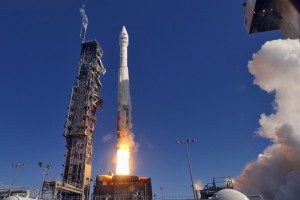
An Atlas V rocket carrying the LDCM satellite successfully lifted off from Vandenberg Air Force Base, California.
The long-awaited Landsat Data Continuity Mission (LDCM)”also known as the Landsat 8 Earth observation satellite”is safely in orbit following a flawless Feb. 11 launch.
At 1:02 p.m. Eastern Standard Time, an Atlas V rocket successfully carried the LDCM satellite into orbit from Vandenberg Air Force Base in California. The LDCM spacecraft separated from the rocket 79 minutes after launch, and the first signal was received 3 minutes later at a ground station in Svalbard, Norway. The solar arrays deployed 86 minutes after launch, and the spacecraft has begun generating power. LDCM is on course to reach a sun-synchronous polar orbit of 438 miles (705 kilometers) above Earth by April 2013.
The new satellite has two main sensors: the Operational Land Imager (OLI) and the Thermal Infrared Sensor (TIRS). OLI will collect images using nine spectral bands”in different wavelengths of visible, near-infrared and shortwave light”to observe a 185-kilometer (115-mile) section of Earth in 30-meter resolution. It will take measurements in two new bands: one to observe high-altitude cirrus clouds and another to observe atmospheric aerosols as well as water quality in lakes and shallow coastal waters.
TIRS will collect data on heat emitted from Earth’s surface in two thermal bands, as compared with a single thermal band on previous Landsat satellites. These thermal band observations are becoming increasingly vital to monitoring water consumption, especially in arid regions.
One of LDCM's predecessors, Landsat 5, recently set a world record for the longest-operating Earth-observing satellite. Launched on March 1, 1984, Landsat 5 watched Earth for 28 years and 10 months”nearly 10 times its expected lifespan. Time ran out for the tenacious satellite when NASA and the U.S. Geological Survey (USGS) announced in December 2012 that Landsat 5 would be decommissioned; it went silent on Jan. 6, 2013.
Landsat 6 failed upon launch in 1993, and Landsat 7 has been in orbit for nearly 14 years, with its fuel running low and its eyesight partially impaired. So the successful launch of LDCM is welcome news to the scientific community as it examines long-term changes on the planet. Mission managers intend to rename the satellite Landsat 8 after it's fully checked out and handed over to USGS later in 2013. Data will be archived and distributed free over the Internet from the Earth Resources Observation and Science (EROS) Center within 100 days of launch.
Image courtesy of NASA.

